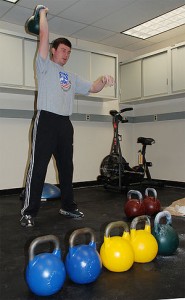Coach Valery Fedorenko shows in the video (below) how even the slightest of movements overhead means that overhead fixation has not been achieved. He would say that you have to experience complete stillness at the top of the movement, in order to understand what is required. In this clip he uses technology to show his athlete just how much motion there might be in an overhead hold .
http://www.youtube.com/watch?v=-CzRaz10w5g
It is more difficult in the snatch than the jerk to achieve that stillness, as the snatch has taken the bell up with much more force, and yet it needs to stop abruptly and as accurately.
So, here’s where I am at with fixation. I can use a full-length mirror to guide the bell up in the air, since I can’t sense it moving through space anymore than I can feel my arm. When I get to the top, I don’t have the sensitivity in my fingers to assess where my hand is within the handle. All I can do is visualise where I want it to end up, and hope to project that movement. It’s a tad tricky to get the arm to stop at precisely the right point, so in training I use a mirror, a metronome, and the rhythm of my breathing to try to gauge it.
All this is manageable though. The difficulty comes with achieving overhead fixation. Other trainers and coaches tell me I need to find the point at which the muscles “switch off” and then I will be able to keep my arm and the bell totally still. But just now I don’t “feel” muscles flex or twitch. So far I have resorted to filming it, to try and establish when that switching off might occur, and resting my lips on the arm, as they are quite sensitive to any vibration.
I have also been experimenting with adding extra weight: this has been quite successful. As I lift over 20kg I begin to receive some feedback via my upperback and my good (well, good-ish!) foot. Not as optimum as feeling it in my arm, maybe, but heck I am happy with any sensation! With even a small amount of feedback, I am battling less to guesstimate my centre of gravity, and have more chance of picking up even the tiniest of audio and visual cues to help me achieve fixation. I have managed to add to the feedback by introducing various textures under my bare feet, so that I curled a square of blanket fabric underfoot as the bell is raised, and then released when I want the bell to be very, very still overhead. It’s almost a cue to my body to create an anchor, because the bell itself doesn’t create that stimulus for me. Now I have dispensed with the fabric – the foot and arm have learnt the pattern.
Audio cues are pretty important to me just now. The sound of my arm moving through the air, the rustle of skin against lycra vest top, the barely tangible sound of my shorts moving as my knees lock. These are what I rely on. At least, for now. I still hope to get over this lack of sensation, and feel the bell right through its trajectory. Then I will have no excuse left for my poor fixation!

